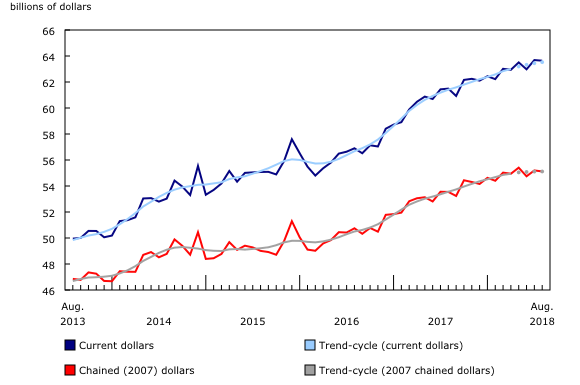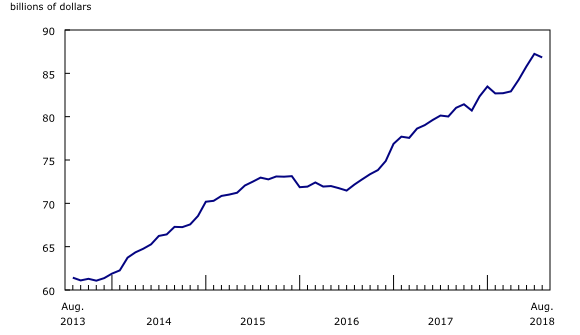Wholesale trade, August 2018
Archived Content
Information identified as archived is provided for reference, research or recordkeeping purposes. It is not subject to the Government of Canada Web Standards and has not been altered or updated since it was archived. Please "contact us" to request a format other than those available.
Released: 2018-10-22
$63.6 billion
August 2018
-0.1% 
(monthly change)
$359.8 million
August 2018
2.0% 
(monthly change)
$80.5 million
August 2018
3.4% 
(monthly change)
$850.9 million
August 2018
-1.2% 
(monthly change)
$560.4 million
August 2018
7.5% 
(monthly change)
$11,847.0 million
August 2018
-0.3% 
(monthly change)
$32,172.8 million
August 2018
-0.5% 
(monthly change)
$1,596.4 million
August 2018
1.9% 
(monthly change)
$2,302.5 million
August 2018
0.4% 
(monthly change)
$6,963.3 million
August 2018
-0.6% 
(monthly change)
$6,820.7 million
August 2018
2.0% 
(monthly change)
$11.4 million
August 2018
-8.2% 
(monthly change)
$64.3 million
August 2018
-0.5% 
(monthly change)
$8.9 million
August 2018
10.0% 
(monthly change)
Wholesale sales edged down 0.1% to $63.6 billion in August. Sales were down in four of seven subsectors, representing 65% of total wholesale sales. The building material and supplies and the motor vehicle and parts subsectors led the declines in August, while the machinery, equipment and supplies subsector posted the largest gain.
In volume terms, wholesale sales edged down 0.1%.
Lower sales in four subsectors
The building material and supplies subsector declined for the second time in three months, down 2.3% to $9.5 billion in August. Sales were down in two of three industries, with the lumber, millwork, hardware and other building supplies industry (-3.5%) contributing the most to the decline. The decrease in August offset the gain in July for both the subsector (+1.2%) and the industry (+0.3%). Related indicators including housing starts (-6.4%), and exports of forestry products and building and packaging materials (-2.8%) also declined in August.
Sales in the motor vehicle and parts subsector fell 1.4% to $10.8 billion on lower sales in all of its industries, led by the motor vehicle industry (-1.4% to $8.5 billion). This was the lowest level for both the subsector and the industry since November 2016. In volume terms, sales in the motor vehicle industry decreased 1.8%.
In the food, beverage and tobacco subsector, sales declined 0.5% to $11.8 billion. Lower sales were reported in all three industries within the subsector. The beverage (-4.9%) and the food (-0.2%) industries contributed the most to the declines in August. In volume terms, the beverage industry declined 5.4%, while the food industry edged up 0.4%.
Following two consecutive monthly gains, the personal and household goods subsector declined 0.5% in both current and constant dollars. Three of six industries reported declines, led by the pharmaceutical and pharmacy supplies industry (-1.4%).
In dollar terms, the machinery, equipment and supplies subsector recorded the largest gain in August. Sales increased for the second consecutive month, up 2.2% to $13.3 billion, the highest level on record. Gains were led by higher sales in the computer and communications equipment and supplies industry (+5.4%), which increased for the second consecutive month.
Sales in the miscellaneous (+1.4% to $8.2 billion) and the farm products (+4.1% to $860 million) subsectors increased in August, following two consecutive monthly declines.
Sales down in four provinces, led by Ontario
Wholesale sales were down in four provinces in August, accounting for 81% of total wholesale sales in Canada. In dollar terms, Ontario contributed the most to the decline.
Sales in Ontario decreased 0.5% to $32.2 billion, with declines in three of seven subsectors. This was the first decline in three months. The building material and supplies subsector contributed the most to the decline in the province, dropping 8.2% in August and bringing the subsector to its lowest level since April 2018. The motor vehicle and parts subsector also contributed to the decline in August, as sales declined 1.4%.
In Alberta, sales declined for the second time in three months, down 0.6% to $7.0 billion. Lower sales were reported in four of seven subsectors, with the food, beverage and tobacco subsector contributing the most to the decline, down 5.3% following a 5.3% increase in July.
Sales in Quebec (-0.3%) and Nova Scotia (-1.2%) declined in August as a result of lower sales in the food, beverage and tobacco, and the miscellaneous subsectors.
Meanwhile, sales in British Columbia reached their highest level on record, up 2.0% to $6.8 billion. The miscellaneous (+6.9%), the food, beverage and tobacco (+3.3%) and the machinery, equipment and supplies (+2.3%) subsectors contributed the most to the gains.
Sales in New Brunswick (+7.5%) and Newfoundland and Labrador (+2.0%) increased, following two consecutive monthly declines. Gains in both provinces were a result of increases in the food, beverage and tobacco subsector.
Inventories decrease for the first time in five months
Wholesale inventories declined 0.5% in August to $86.8 billion. Decreases in four subsectors, representing 44% of total wholesale inventories, were partly offset by gains in the three other subsectors.
Inventories in the personal and household goods subsector decreased 4.1% in August, accounting for the largest drop in dollar terms. The personal goods and the pharmaceuticals and pharmacy supplies industries contributed the most to the decline.
Following two consecutive monthly gains, the food, beverage and tobacco subsector decreased 1.9% in August. Lower inventory levels in the food industry (-2.0%) contributed the most to the drop.
Higher inventories in the machinery, equipment and supplies subsector (+1.4%) were led by higher stock levels in the construction, forestry, mining, and industrial machinery, equipment and supplies (+1.7%) and the farm, lawn and garden machinery and equipment (+2.5%) industries.
Inventories in the miscellaneous subsector (+0.9%) rose for the sixth consecutive month on the strength of gains in four of its five industries.
The inventory-to-sales ratio decreased from 1.37 in July to 1.36 in August. This ratio is a measure of the time in months required to exhaust inventories if sales were to remain at their current level.
Note to readers
All data in this release are seasonally adjusted and expressed in current dollars, unless otherwise noted. For information on seasonal adjustment, see Seasonally adjusted data – Frequently asked questions.
Total wholesale sales expressed in volume are calculated by deflating current dollar values using relevant price indexes. The wholesale sales series in chained (2007) dollars is a chained Fisher volume index with 2007 as the reference year. For more information, see Sales in volume for Wholesale Trade.
The Monthly Wholesale Trade Survey covers all industries within the wholesale trade sector as defined by the North American Industry Classification System (NAICS), with the exception of oilseed and grain merchant wholesalers (NAICS 41112), petroleum and petroleum products merchant wholesalers (NAICS 412) and business-to-business electronic markets, and agents and brokers (NAICS 419).
For information on trend-cycle data, see the StatCan Blog and Trend-cycle estimates – Frequently asked questions.
Revisions
Each month, the Monthly Wholesale Trade Survey incorporates revisions. Factors influencing revisions include the late receipt of respondent information, the correction of information in the data provided, the replacement of estimated figures with actual values (once available) and the re-classification of companies within, into and out of the wholesale trade sector.
Real-time data tables
Real-time data tables 20-10-0019-01, 20-10-0020-01 and 20-10-0005-01 will be updated on November 5.
Next release
Wholesale trade data for September will be released on November 21.
Contact information
For more information, or to enquire about the concepts, methods or data quality of this release, contact us (toll-free 1-800-263-1136; 514-283-8300; STATCAN.infostats-infostats.STATCAN@canada.ca) or Media Relations (613-951-4636; STATCAN.mediahotline-ligneinfomedias.STATCAN@canada.ca).
- Date modified:



